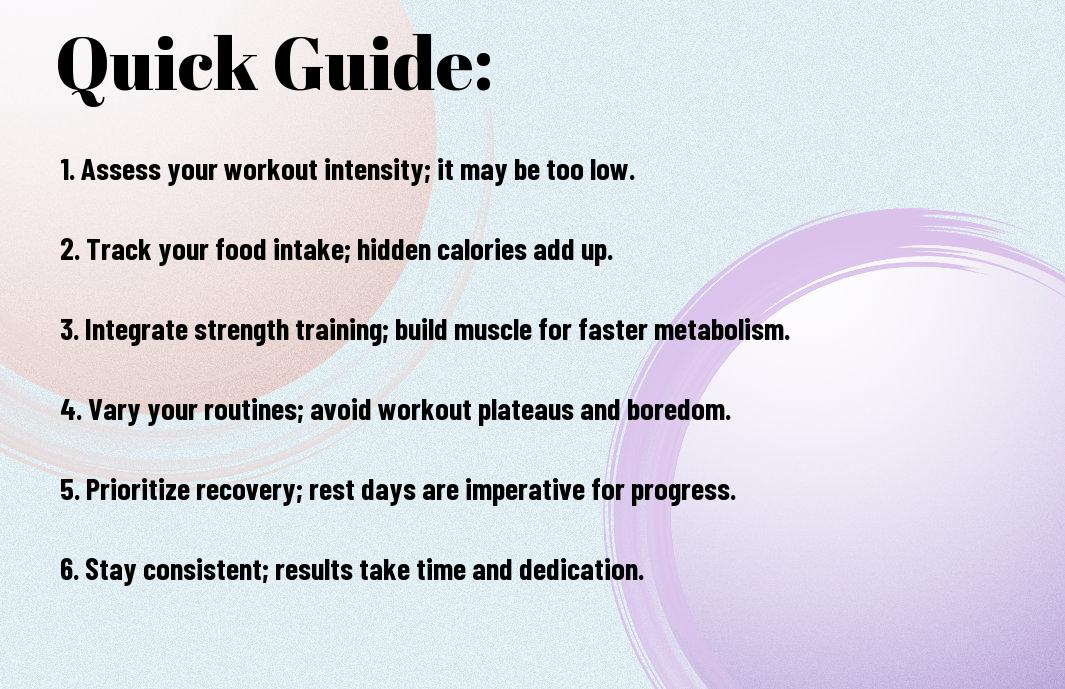This guide will help you understand why your current workout routine has not yielded the weight loss results you desire. If you find yourself putting in the effort yet failing to shed pounds, it’s time to assess your approach. From exercise selection to workout intensity, several factors might be hindering your progress. By identifying and addressing these issues, you can optimize your routine to effectively support your weight loss goals. Let’s explore the common pitfalls and how to adjust your workouts for better results.
Key Takeaways:
- Lack of Intensity: Your workout may not be challenging enough to burn significant calories, necessitating an increase in intensity.
- Inadequate Variety: Repeating the same routine can lead to a plateau; mixing different exercises can boost your metabolism.
- Neglecting Nutrition: Exercise alone won’t suffice for weight loss; a balanced diet is necessary for effective results.
- Ignoring Recovery: Insufficient rest can hinder weight loss by increasing stress and leading to unhealthy food choices.
- Fixing Mindset: A positive and focused mindset is vital; set realistic goals to maintain motivation and progress.

Understanding Workout Types
For effective weight loss, it’s crucial to recognize the different types of workouts available. Each type serves unique purposes and adjusting your regimen could enhance your results. Here’s a breakdown:
| Workout Type | Description |
|---|---|
| Cardio | Involves sustained activities like running or cycling that elevate heart rate. |
| Strength Training | Focuses on building muscle through weights or resistance exercises. |
| HIIT | Short bursts of intense activity followed by brief recovery periods. |
| Flexibility Workouts | Involves stretching to improve flexibility and prevent injury. |
| Functional Training | Exercises that mimic everyday activities to improve overall fitness. |
The type of workout you choose should align with your fitness goals.
Cardio vs. Strength Training
Workout types like cardio and strength training each contribute differently to your fitness journey. Cardio helps burn calories, improve cardiovascular health, and boost endurance, while strength training builds lean muscle mass, which can increase your resting metabolic rate. Combining both will yield the best results for weight loss.
High-Intensity Interval Training (HIIT)
Types of HIIT involve alternating between short, high-intensity bursts of exercise and brief rest periods. This method is highly effective for burning calories in less time compared to traditional workouts. You can achieve significant results through just a few sessions per week (consider incorporating HIIT into your routine for optimal effectiveness).
To maximize benefits, focus on exercises that engage multiple muscle groups during HIIT sessions. As your fitness level improves, you can increase the intensity and reduce rest periods for greater calorie burn (adjusting your HIIT approach can lead to better outcomes).
Common Factors Hindering Weight Loss
While you may be putting in the effort at the gym, several factors can impede your weight loss journey. These include:
- Insufficient calorie deficit
- Poor sleep patterns
- Chronic stress levels
- Inconsistent workout routine
- Neglecting proper hydration
Any of these elements could be holding you back from achieving your fitness goals.
Metabolism and Genetics
While your metabolism and genetic makeup can influence weight loss, they aren’t insurmountable obstacles. Understanding your body’s unique metabolic rate is key, as some people naturally burn calories more efficiently than others. Furthermore, genetics can affect where you store fat and how quickly you gain or lose it. (Being aware of these factors lets you tailor your approach for better outcomes.)
Nutritional Habits
Metabolism can be significantly affected by your nutritional choices. What you eat can hinder or support your weight loss efforts, regardless of how much you exercise. Choosing nutrient-dense foods over processed options is pivotal in fostering a healthier metabolism.
For instance, if you’re indulging in high-calorie, low-nutrient foods, your body may struggle to create the energy necessary for effective workouts. Opting for whole grains, lean proteins, and a variety of fruits and vegetables can improve energy levels and foster more efficient calorie burning. This shift in your nutritional habits can lead to better weight management and overall health.
Key Tips for Effective Workouts
Not every workout will yield the results you desire. To maximize your efforts, consider incorporating these key tips:
- Set specific goals.
- Track your progress.
- Prioritize strength training.
- Mix in cardio.
- Stay consistent.
The combination of these elements can transform your routine and enhance weight loss.
Setting Realistic Goals
Setting realistic goals is vital for your fitness journey. (Aim to achieve small, attainable milestones instead of overwhelming yourself with lofty targets.) Start by identifying what you want to achieve and break it down into manageable steps.
Incorporating Variety into Routines
Into your workouts, you should regularly introduce new exercises and techniques. (This approach prevents plateaus and keeps you engaged.) A varied routine can boost your motivation while targeting different muscle groups, enhancing overall results.
For instance, try alternating between strength training, high-intensity interval training (HIIT), and outdoor activities like running or cycling. Mixing different types of workouts not only enhances your physical capabilities but also maintains your enthusiasm and commitment to your fitness plan. (Aim to change your routine every few weeks to keep your body guessing.)
Step-by-Step Guide to Revamping Your Workout
Despite following a routine, many find their workouts falling short of weight loss goals. Revamping your workout involves evaluating your current methods and making necessary adjustments. This structured approach will help maximize your fitness results and boost motivation.
Assessing Current Fitness Level
| Step | Description |
| Evaluate Strength | Identify areas of strength and weakness through various exercises. |
| Cardio Assessment | Gauge your cardiovascular fitness with simple endurance tasks. |
| Flexibility Check | Test your flexibility with stretching exercises to spot limitations. |
Assessing Current Fitness Level
You need to know where you currently stand to effectively change your workout routine. Understanding your fitness level allows you to set realistic goals and tailor your program accordingly. (You might discover areas for improvement that could significantly impact your results.)
Creating a Balanced Workout Plan
Even slight adjustments can lead to significant results in your fitness journey. A well-rounded workout plan combines strength training, cardio, and flexibility exercises to enhance overall fitness. (It’s important to find a balance that fits your lifestyle and keeps you engaged.)
Step-by-step, building a balanced workout plan ensures no aspect of fitness is neglected. Incorporate strength exercises to boost metabolism, add cardio for heart health and weight loss, and don’t forget flexibility work to prevent injuries. (Prioritizing variety can make your routine enjoyable and sustainable.)
Pros and Cons of Different Workout Strategies
After exploring various workout strategies, it’s important to weigh their advantages and disadvantages. Each method has its unique features that can impact your weight loss journey differently.
| Workout Strategy | Pros and Cons |
|---|---|
| High-Intensity Interval Training (HIIT) | Pros: Burns calories quickly, boosts metabolism. Cons: Can be intense for beginners. |
| Strength Training | Pros: Builds muscle, increases resting metabolic rate. Cons: Requires proper form to avoid injury. |
| Group Classes | Pros: Social interaction, structured environment. Cons: May not suit everyone’s pace. |
| Yoga | Pros: Improves flexibility, reduces stress. Cons: May not significantly aid in weight loss. |
| Traditional Cardio | Pros: Improves cardiovascular health. Cons: Can lead to muscle loss if overdone. |
| Outdoor Activities | Pros: Fresh air, variety. Cons: Weather-dependent. |
| Online Workouts | Pros: Convenience, flexible scheduling. Cons: Less motivation without in-person support. |
| Mind-Body Exercises | Pros: Enhances mental focus, lowers anxiety. Cons: May have minimal caloric burn. |
| Functional Movement Training | Pros: Improves overall performance, real-world strength. Cons: Sometimes requires equipment. |
| Mixed Routine | Pros: Well-rounded fitness, variety prevents boredom. Cons: Can be overwhelming to plan. |
Benefits of Group Classes
Any individual who participates in group classes often finds the social aspect motivating. The energy of a collective workout can push you to perform better and stick to your fitness goals. Moreover, a structured schedule helps you stay accountable, while diverse routines keep your workouts interesting.
Drawbacks of Solely Relying on Traditional Cardio
One major issue with relying solely on traditional cardio is the risk of overtraining without sufficient strength training. While cardio is excellent for burning calories, it may not be as effective for preserving muscle mass, which is vital for maintaining a healthy metabolism. Without muscle, your body may burn fewer calories at rest, hindering your weight loss progress.
It’s important to balance your cardio regimen with other forms of exercise rather than focusing exclusively on running, cycling, or similar aerobic activities. Over time, continuous traditional cardio can lead to diminishing returns in terms of weight loss, as your body adapts to the constant stress. Incorporating strength training, flexibility work, or high-intensity sessions will create a well-rounded routine that enhances your overall fitness and aids in sustainable weight loss.

Motivation and Mindset for Weight Loss
To achieve lasting weight loss, your motivation and mindset are vital. It’s not just about the calories burned but also your psychological approach to fitness and eating. A positive mindset can help you overcome barriers and keep you focused on your goals while understanding that setbacks are a part of the journey. Building a healthy attitude towards both your body and your fitness journey is key in maintaining motivation for weight loss.
Building a Support System
You can significantly enhance your weight loss journey by surrounding yourself with supportive individuals. Seek friends, family, or workout buddies who share similar health and fitness goals. This network will not only hold you accountable but also provide encouragement during challenging moments, making the process more enjoyable and effective.
Staying Committed to Change
One way to ensure you stay on track with your weight loss is to develop habits that support your commitment to change. Each small step you take helps solidify your dedication to a healthier lifestyle. Set achievable goals, track your progress, and celebrate milestones to reinforce your commitment. Adapting to a new way of living takes time, and embracing the journey will keep you motivated.
Weight loss is not solely about the end goal; it’s about the daily choices you make. Creating a routine that prioritizes healthy eating and regular exercise will help you stay committed over the long term. Acknowledge that change is a gradual process, and it’s important to remain flexible and patient with yourself. Over time, these commitments will transform into habits that make maintaining a healthy lifestyle easier and more instinctive.
Final Words
As a reminder, if your current workout isn’t helping you lose weight, it may be time to re-evaluate your approach. Consider the intensity and duration of your workouts, the variety in your routine, and your overall nutrition. Incorporating strength training, adjusting your calorie intake, and ensuring adequate recovery can significantly impact your results. By taking a holistic view of your exercise, diet, and lifestyle, you can create an effective strategy that truly supports your weight loss goals.
FAQ
Q: Why am I not losing weight despite working out regularly?
A: There are several reasons why regular workouts might not lead to weight loss. One common issue is that people often overestimate the calories burned during exercise and underestimate their caloric intake. Additionally, your body may adapt to your current workout, leading to a plateau in weight loss. Consider varying your routine or increasing the intensity of your workouts to challenge your body in new ways. Also, ensure that you’re maintaining a balanced diet that supports your weight loss goals.
Q: What role does diet play in my weight loss efforts compared to exercise?
A: Diet plays a significant role in weight loss, often more so than exercise alone. While physical activity increases caloric expenditure, the types and quantities of food consumed significantly affect overall calorie balance. For effective weight loss, it’s necessary to pair a consistent workout routine with a healthy diet. Monitoring portion sizes, choosing nutrient-dense foods, and reducing sugar and processed foods can complement your exercise efforts, leading to more noticeable results.
Q: How can I modify my workout to promote weight loss?
A: Modifying your workout can be achieved through various strategies. First, incorporate a mix of cardiovascular exercises, strength training, and high-intensity interval training (HIIT) to maximize calorie burn. Increasing the duration or frequency of your workouts can also help. Additionally, adding new exercises or changing your routine every few weeks can keep your body challenged. Lastly, focus on your workout intensity and ensure you’re working at a level that raises your heart rate and keeps it elevated for optimal fat loss.










Reply